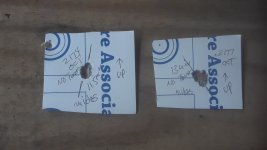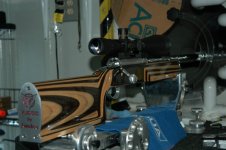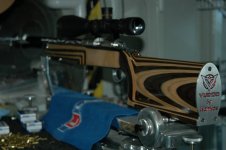M
You are using an out of date browser. It may not display this or other websites correctly.
You should upgrade or use an alternative browser.
You should upgrade or use an alternative browser.
Vudoo V22S SS/F Class Action
- Thread starter Ravage88
- Start date
I'm relatively new to benchrest shooting. I have asked on SH but haven't really received direct responses. I'm going to order a V22s with shilen barrel but still am undecided on a barrel length. What is the general consensus of barrel length for benchrest shooting?
Your barrel length won't be pre-ordained but instead, determined by the best place to crown it.
MB
Your barrel length won't be pre-ordained but instead, determined by the best place to crown it.
MB
Oh. I was just wondering because they gave options on specific lengths. I understand it could vary a bit based on the tightest location. So the barrel can be anywhere from 16 to 24 on the shilen? It really doesn't matter I just am asking for the sake of ordering purposes.
Oh. I was just wondering because they gave options on specific lengths. I understand it could vary a bit based on the tightest location. So the barrel can be anywhere from 16 to 24 on the shilen? It really doesn't matter I just am asking for the sake of ordering purposes.
It won't go that short.
MB
It won't go that short.
MB
So when I call to order, barrel length won't be an option I have to give? Just getting my ducks in row.
So when I call to order, barrel length won't be an option I have to give? Just getting my ducks in row.
FWIW for a BR rifle you want the longest barrel the blank permits given the previous mentioned requirements.
It seems they will be 24" or so at a minimum.
You should specify" as long as the blank will allow" and will likely result in the best that blank will yield.
Picking a pre determined OAL for this game should be avoided, I would assume MB will tell you same.
Last edited:
FWIW for a BR rifle you want the longest barrel the blank permits given the previous mentioned requirements.
It seems they will be 24" or so at a minimum.
You should specify" as long as the blank will allow" and will likely result in the best that blank will yield.
Picking a pre determined OAL for this game should be avoided, I would assume MB will tell you same.
Yessir and thanks Tim, I hadn't had a chance to roll back through here yet, but that's exactly the approach to recommend as the order is placed.
MB
Your barrel length won't be pre-ordained but instead, determined by the best place to crown it.
MB
How exactly do you go about determining the correct spot for the crown? What parameter or ?? are you looking for? I have slugged a few barrels and maybe measured a few too and am curious as to what you are looking for that says "cut me here"? How much tolerance do you have on the area to be cut? 0.010, 0.100, 1.00 etc. I have my way of determining length, but I will bet it is different than anybody talking about it here. I like to see what others do.
How exactly do you go about determining the correct spot for the crown? What parameter or ?? are you looking for? I have slugged a few barrels and maybe measured a few too and am curious as to what you are looking for that says "cut me here"? How much tolerance do you have on the area to be cut? 0.010, 0.100, 1.00 etc. I have my way of determining length, but I will bet it is different than anybody talking about it here. I like to see what others do.
Interesting. Might I inquire Your method Jerry ?
How exactly do you go about determining the correct spot for the crown? What parameter or ?? are you looking for? I have slugged a few barrels and maybe measured a few too and am curious as to what you are looking for that says "cut me here"? How much tolerance do you have on the area to be cut? 0.010, 0.100, 1.00 etc. I have my way of determining length, but I will bet it is different than anybody talking about it here. I like to see what others do.
Well, this is a good question and bear in mind, I'm really new at this, but I'm a fast learner. First, every barrel goes through a pretty detailed hardness testing process before moving into a vat of boiling mineral oil. If it doesn't fall within a strict range of hardness, we don't use it for BP150 and it's saved for the IR50/50 guys. The hot mineral oil makes the material more malleable but you have to be very careful to avoid permanently affecting the grain structure. We then move the barrels to what, in essence, is a modified sausage casing machine that we use to turn the barrel inside/out.
Once turned, the barrels are racked in a way that maintains the malleable state and without damaging the rifling, because it's now on the outside of the barrel. We start a timer because we can't leave them like this for long, so they're rushed to a custom made horizontal CMM that we've interfaced with an electron microscope. Once we locate the feature we're looking for (can't share this part, its proprietary), we prep the cut off tools, which we source from the dental industry....You guessed it, they're the little rubber bands that were once used on kids braces. Since the material is maintained in a malleable state, it doesn't take many rubber bands to cleanly cut the material but the cool thing is, based on the quality of the constriction, the crown becomes a collateral feature of cutting the barrel.
After the cut and crown, we quickly move the barrels back to the modified sausage casing machine so we can return it to it's usable configuration where the rifling is actually back on the inside of the barrel. Now, the most important part, the heat treat process. But, before taking the barrels out to an open fire in the back yard, we insert a rod, certified for straightness, through the bore. If you've ever roasted hot dogs on an open fire, you get the rest of this part of the process so I won't go into too much detail about it. I'll add though, the heat treating is done by hand, no machines, no temp gauges or timers, just old world craftsmanship that I learned from the only book ever written about "rimfire accuracy." You should grab a copy!!!!
Thanks Jerry!
MB
Last edited:
J
Jstensvad
Guest
Dear Mike,
I hate to tell you that was an overly long and poor attempt at humor!
Jim S.
I hate to tell you that was an overly long and poor attempt at humor!
Jim S.
Interesting. Might I inquire Your method Jerry ?
You can inquire, actually I think you just did. I cut my barrels to specific lengths based on empirical evidence I derived from a test that Jerry Hensler and I ran cutting barrels off a little at a time. There is a mathematical formula for it, but we don't share it.
I always hear of people cutting barrels where they feel a choke by slugging or measuring "roundness". I can somewhat agree with the choke method, but wonder how close they think they can feel when it starts etc and where to cut. I would think it is no better than a 1/4 inch or so. I call BS on the roundness measuring. IF the barrels are out of round at some specific spot and not others, how do you ever determine that and HOW could it ever get that way. I really call "BS" on that method.
Personally, if the barrel is not very evenly tapered such that I can cut it where my length formula says to, I fix the barrel by lapping it to make it even or toss it. I almost never toss one though. In my opinion a good EVEN taper is needed in these barrels to shoot well. The exact sizes and amounts I don't talk about. Paul Tolvstad worked with me on this and we have determined what we like to see. That is one of the reasons that people pay Paul to lap their barrels correctly and that is why we don't publish numbers and our exact methods used.
Dear Mike,
I hate to tell you that was an overly long and poor attempt at humor!
Jim S.
Well, what did I have to lose? Instead of posting a lot of ambiguous info and stating it isn't something I talk about, I chose to approach it in a more comical way. I could've chosen to not respond at all, but Jerry and I have always had the kind of back and forth that I knew he'd get a chuckle out of it. No reason to be so serious all the time....it ain't healthy.
MB
Jerry H
Different Drummer
Here are pictures of 10 shot groups, shot with 2 new barrels that Jerry Stiller lapped and I chambered and cut to a very specific length. I think the lapping is critical on how well a barrel will shoot. They were tested with the same 2500X rifle and the same known good lot of Midas ammo. They both measure about the same vertical (11.5mm OTO). One was shot on a very calm day and the other was on a mild windshield wiper type wind, 2 days later. You can guess which group was shot with which day's conditions. As these tests were about checking the barrels, no tuner was used. So much for the parallel node theory as this should not be possible with a naked barrel. I also do my initial ammo lot tests without the tuner on.


Last edited:
You can inquire, actually I think you just did. I cut my barrels to specific lengths based on empirical evidence I derived from a test that Jerry Hensler and I ran cutting barrels off a little at a time. There is a mathematical formula for it, but we don't share it.
I always hear of people cutting barrels where they feel a choke by slugging or measuring "roundness". I can somewhat agree with the choke method, but wonder how close they think they can feel when it starts etc and where to cut. I would think it is no better than a 1/4 inch or so. I call BS on the roundness measuring. IF the barrels are out of round at some specific spot and not others, how do you ever determine that and HOW could it ever get that way. I really call "BS" on that method.
Personally, if the barrel is not very evenly tapered such that I can cut it where my length formula says to, I fix the barrel by lapping it to make it even or toss it. I almost never toss one though. In my opinion a good EVEN taper is needed in these barrels to shoot well. The exact sizes and amounts I don't talk about. Paul Tolvstad worked with me on this and we have determined what we like to see. That is one of the reasons that people pay Paul to lap their barrels correctly and that is why we don't publish numbers and our exact methods used.
One follow up.
Since it would seem you've gotten pretty good at lapping a nice progressive taper I guess we could assume, by default with your OAL methodology you would also tend to end up with a muzzle at pretty much the tightest spot, would this be a correct assumption ?
Here are pictures of 10 shot groups, shot with 2 new barrels that Jerry Stiller lapped and I chambered and cut to a very specific length. I think the lapping is critical on how well a barrel will shoot. They were tested with the same 2500X rifle and the same known good lot of Midas ammo. They both measure about the same vertical (11.5mm OTO). One was shot on a very calm day and the other was on a mild windshield wiper type wind, 2 days later. You can guess which group was shot with which day's conditions. As these tests were about checking the barrels, no tuner was used. So much for the parallel node theory as this should not be possible with a naked barrel. I also do my initial ammo lot tests without the tuner on.
View attachment 23783
Those are nice targets. I don't have targets to post but I can report that at the Arkansas State Tournament today, there were two Ivanhoe rifles that have been through the above process and they place first and fifth out of 30 shooters. Greg Monroe pulled off first place with Bill Drummond placing fifth but posting high card. Something to be said for those sausage casing machines....
MB





